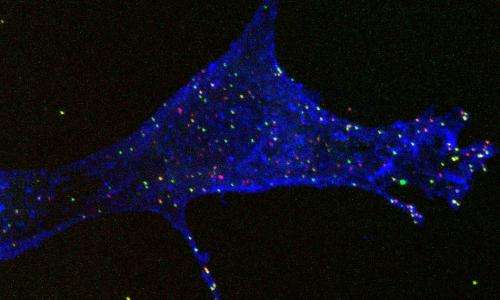Mechanism of dengue virus entry into cells revealed

Dengue fever, an infectious tropical disease caused by a mosquito-borne virus, afflicts millions of people each year, causing fever, headache, muscle and joint pains and a characteristic skin rash. In some people the disease progresses to a severe, often fatal, form known as dengue hemorrhagic fever. Despite its heavy toll, the prevention and clinical treatment of dengue infection has been a "dramatic failure in public health compared to other infectious diseases like HIV," said Ping Liu of the University of North Carolina at Chapel Hill.
Now, new research by Liu and her colleagues, to be presented at the 58th Annual Biophysical Society Meeting, which takes place in San Francisco from Feb. 15-19, could offer vital insight into the mechanism of dengue virus entry into cells—and aid vaccine and clinical drug development.
Specifically, Liu, a postdoctoral scholar in the laboratories of cell biologist Ken Jacobson and biophysical chemist Nancy Thompson, along with dengue fever expert Aravinda de Silva, used high-resolution microscopes to examine the expression of a particular protein, known as DC-SIGN (for dendritic cell-specific intercellular adhesion molecule-grabbing nonintegrin), on the surface of immune system cells called dendritic cells.
The normal role of DC-SIGN is to capture pathogens so that fragments of those pathogens can be presented as antigens on the surface of the dendritic cells. Such antigens then are recognized by T cells—the workhorse cells of the immune system—"which is one of the first steps in the normal immune response," Liu said.
While it has been known for some time that dengue used DC-SIGN to attach to cells, Liu and her colleagues used high-resolution microscopy to study exactly how the viruses used the protein to gain entry into cells. "DC-SIGN has a unique carbohydrate recognition domain on its extracellular portion, which binds to all sorts of carbohydrates on pathogens," she explained. (Other pathogens, including HIV and the bacterium that causes tuberculosis, are likely to use the same back door).
"An effective medication or vaccine should stop the process of dengue virus entry into cells," Liu said. To that end, she said, de Silva and his colleagues have identified strong neutralization antibodies that block dengue infection. "We are looking into the details of how those neutralization antibodies act and the role of DC-SIGN in the neutralization process."
By identifying the mechanism of antibody neutralization, Liu and colleagues hope to advance the development of vaccines for Dengue virus infections.
More information: The presentation "Dengue Virus Infection Mediated by DC-SIGN" by Ping Liu, Marc R. Ridilla, Aravinda M. de Silva, Nancy L. Thompson and Ken Jacobson will be at noon on Monday, February 17, 2014 in Room 305 in San Francisco's Moscone Convention Center. Abstract: tinyurl.com/mj5j2nz
Provided by American Institute of Physics
















